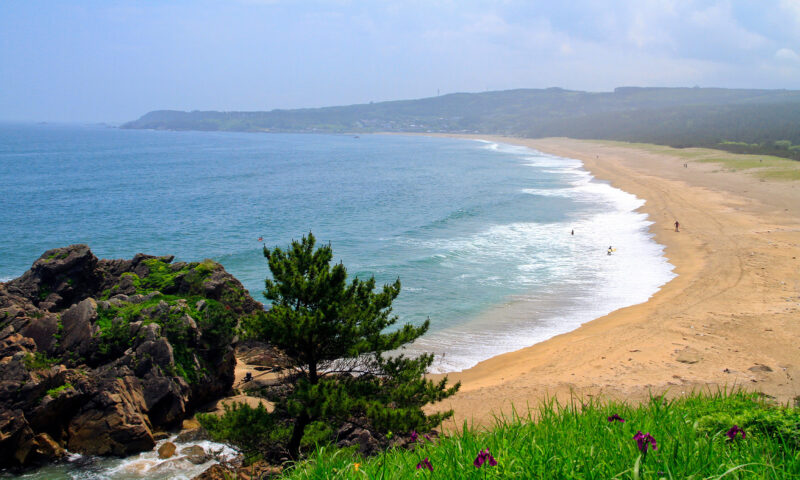Nestled on the picturesque coastline of Aomori Prefecture in northern Japan, Hachinohe (八戸市) offers an authentic glimpse into traditional Japanese culture far from the tourist crowds of Tokyo and Kyoto. With its fresh seafood, vibrant local festivals, rich history, and breathtaking natural landscapes, this hidden gem provides American travelers with an opportunity to experience the real Japan that few tourists ever see.
- Introduction to Hachinohe: Japan’s Northern Coastal Gem
- History and Cultural Heritage
- Top Attractions in Hachinohe
- Culinary Experiences: Seafood Paradise
- Seasonal Festivals and Cultural Events
- Natural Wonders Around Hachinohe
- Travel Tips for Americans Visiting Hachinohe
- Where to Stay in Hachinohe
- Why Hachinohe Deserves a Place on Your Japan Itinerary
Table of Contents
- Introduction to Hachinohe
- History and Cultural Heritage
- Top Attractions
- Culinary Experiences
- Seasonal Festivals
- Natural Wonders
- Travel Tips for Americans
- Where to Stay
- Conclusion
Introduction to Hachinohe: Japan’s Northern Coastal Gem
Located in the southeastern part of Aomori Prefecture, Hachinohe is a coastal city of approximately 230,000 residents. While it might not appear on many standard Japan itineraries, this working port city offers travelers an authentic Japanese experience with significantly fewer crowds than Japan’s major tourist destinations.
Hachinohe Quick Facts
- Location: Aomori Prefecture, northern Japan (Tohoku region)
- Population: Approximately 230,000
- Known for: Fresh seafood, fishing industry, Sansha Taisai Festival
- Climate: Cool summers and snowy winters (similar to northern New England)
- Access: 3 hours from Tokyo via Shinkansen (bullet train)
For American travelers seeking to venture beyond Japan’s well-trodden tourist path, Hachinohe represents an opportunity to experience a side of Japan that maintains strong connections to traditional ways of life while embracing modern conveniences. The city’s relatively compact size makes it easily navigable, while its location serves as an excellent gateway to exploring the wider Tohoku region.
History and Cultural Heritage
Hachinohe’s history stretches back centuries, with evidence of human settlement dating to the Jomon period (14,000-300 BCE). The city’s strategic coastal location has made it an important trading hub throughout Japanese history.
During the Edo period (1603-1868), Hachinohe developed as a castle town under the Nambu clan, who ruled the region for over 700 years. Though the original castle no longer stands, the cultural influence of this era remains evident in local traditions, architecture, and festivals.
In the modern era, Hachinohe evolved into an important fishing and industrial port, particularly after World War II. Today, the city successfully balances its industrial heritage with cultural preservation and tourism development.
Nambu Culture
The Nambu clan’s influence can still be seen throughout Hachinohe in traditional crafts, including Nambu ironware (Nambu tekki), a distinctive style of cast iron teapots and cookware prized for their craftsmanship. These items make excellent souvenirs that combine beauty, functionality, and cultural significance—something American visitors often seek when traveling abroad.
Top Attractions in Hachinohe
1. Kabushima Shrine
Perched dramatically on a small island connected to the mainland, Kabushima Shrine is famous for its thousands of black-tailed gulls that nest in the area. This iconic red shrine against the backdrop of the Pacific Ocean offers spectacular photo opportunities and a peaceful spiritual experience. The shrine is dedicated to Benzaiten, the goddess of everything that flows (water, music, words), and is considered a power spot by many Japanese.
2. Hachinohe Umineko Market (Morning Market)
For an authentic glimpse into local life, visit the bustling Hachinohe Morning Market, one of Japan’s largest morning markets. With over 300 stalls selling fresh seafood, local produce, and regional specialties, it’s the perfect place to experience the daily rhythm of this fishing community. Americans who enjoy farmers’ markets back home will find this a familiar yet distinctly Japanese experience.
3. Tanesashi Coast
Part of the Sanriku Fukko National Park, the Tanesashi Coastline is renowned for its pristine natural beauty. Unlike many of Japan’s beaches, which are developed with concrete embankments, this coastline preserves its natural state with rolling green grasslands meeting white sandy beaches and crystal-clear waters. The scenic coastal walking path offers breathtaking views that rival those of California’s Big Sur or Maine’s rocky shores.
4. Hachinohe Museum of Art
Housing an impressive collection of modern and contemporary art with a focus on works from the Tohoku region, this museum provides cultural context for understanding northern Japan’s artistic heritage. The museum’s architecture itself, designed by Tadao Ando, is worth appreciating for visitors interested in contemporary Japanese design.
5. Yomogida Onsen
No visit to Japan is complete without experiencing an onsen (hot spring bath). Yomogida Onsen offers a traditional bathing experience in a serene setting. For Americans new to communal bathing, this countryside onsen provides a more relaxed introduction to this quintessential Japanese custom than busier hot springs in tourist areas.
Culinary Experiences: Seafood Paradise
As a major fishing port, Hachinohe is renowned throughout Japan for its extraordinary seafood. The cold waters of the Pacific Ocean here produce some of the freshest and most flavorful seafood in the country.
Must-Try Local Specialties
- Ichigo-ni: A unique sea urchin and abalone soup considered Hachinohe’s signature dish
- Senbei-jiru: A hearty miso-based soup containing rice crackers (senbei), vegetables, and chicken or seafood
- Hachinohe Saba (Mackerel): Locally caught mackerel prepared in various ways
- Hachinohe Ramen: A local variation featuring a light, clear broth topped with char siu pork and bamboo shoots
- Hasshoku Center: Not a dish but a destination—this massive indoor market allows visitors to purchase seafood and have it prepared on the spot
For American visitors accustomed to Japanese restaurants at home, Hachinohe offers an opportunity to experience how seafood is meant to taste when served mere hours after being caught. The emphasis on seasonal ingredients and minimal preparation allows the natural flavors to shine through in a way that’s both revelatory and delicious.
Seasonal Festivals and Cultural Events
Hachinohe’s calendar is marked by colorful festivals that provide windows into traditional Japanese culture and community life. These events offer American visitors rare opportunities to witness celebrations that have remained largely unchanged for centuries.
Sansha Taisai Festival (August 1-5)
Hachinohe’s most famous festival and one of the Tohoku region’s major summer events, the Sansha Taisai dates back over 300 years. The festival features elaborate floats, traditional music, and tiger dances. The highlight is the parade of 27 enormous decorated floats (some standing over 10 meters tall) pulled through the streets by local residents. This festival has been designated an Important Intangible Folk Cultural Property of Japan.
Emburi Festival (February)
This winter festival is a prayer for good harvests, featuring performers in distinctive straw hats who shake their heads vigorously to simulate the wind blowing through rice plants. The rhythmic movements and traditional music create a hypnotic atmosphere that connects modern participants to ancient agricultural traditions.
Hachinohe Enburi (December)
This winter festival features elaborate snow sculptures throughout the city, illuminated at night to create a magical winter wonderland. For Americans from warmer regions, this offers a chance to experience how Japanese communities embrace and celebrate the harsh winter season rather than merely enduring it.
Natural Wonders Around Hachinohe
The area surrounding Hachinohe boasts diverse natural landscapes that rival Japan’s more famous scenic areas but with far fewer tourists.
Lake Towada and Oirase Gorge
About an hour from Hachinohe, Lake Towada is a beautiful dual-crater lake surrounded by forests. The Oirase Stream flows from the lake through a picturesque gorge with numerous waterfalls. The walking trail along the stream is considered one of Japan’s most beautiful forest walks, especially during fall foliage season. Americans who enjoy hiking in national parks will find this area offers comparable natural beauty to places like the Great Smoky Mountains but with a distinctly Japanese character.
Mount Hakkoda
This volcanic mountain range offers spectacular hiking in summer and world-class powder snow for skiing in winter. The “snow monsters” (trees completely encased in snow and ice) that form here in winter create an otherworldly landscape that photographers will particularly appreciate.
Ashigezaki Lookout
This dramatic coastal viewpoint offers panoramic views of rugged cliffs and the Pacific Ocean. On clear days, you can see all the way to the Shimokita Peninsula, creating postcard-perfect photo opportunities.
Travel Tips for Americans Visiting Hachinohe
Practical Information
- Getting There: Take the Tohoku Shinkansen from Tokyo to Hachinohe Station (approximately 3 hours)
- Local Transportation: The city has a bus network, but renting a car is recommended for exploring the surrounding countryside
- Best Time to Visit: Late spring (May-June) for mild weather and coastal beauty; early October for fall foliage
- English Prevalence: Less common than in major cities, but basic English is understood in main tourist areas
- Currency: Cash is still king in smaller establishments; ensure you have Japanese yen on hand
Cultural Tips
In Hachinohe, as in much of provincial Japan, traditional customs are observed more strictly than in Tokyo. Americans will be welcomed warmly, especially if they make even small efforts to respect local customs:
- Remove shoes when indicated in ryokans (traditional inns), some restaurants, and private homes
- Learn basic Japanese greetings (konnichiwa, arigatou)
- Bow slightly when greeting people
- Accept business cards with both hands if offered
- Don’t tip—it’s not customary and may cause confusion
Language Bridge
While English isn’t as widely spoken in Hachinohe as in major tourist cities, don’t let this deter you. Local residents often go out of their way to help visitors, and translation apps can bridge most communication gaps. Many Americans find that some of their most memorable experiences in Japan come from these unexpected cross-cultural interactions in places like Hachinohe where tourism feels less scripted.
Where to Stay in Hachinohe
Hachinohe offers a range of accommodations to suit different preferences and budgets:
Traditional Experience: Ryokans
For an authentic Japanese experience, consider staying at a ryokan (traditional inn) with tatami floors, futon bedding, and often an on-site onsen. These accommodations typically include a traditional multi-course kaiseki dinner featuring local specialties. For Americans, this offers a complete immersion into Japanese hospitality traditions that date back centuries.
Modern Convenience: Business Hotels
Several clean, efficient business hotels are located near Hachinohe Station, offering Western-style beds and amenities at reasonable prices. While rooms are typically smaller than American hotel rooms, they provide comfortable, convenient bases for exploring the city.
Coastal Retreats
Some accommodations along the scenic coastline offer stunning ocean views and direct access to beaches or hiking trails. These properties often combine traditional Japanese elements with modern conveniences, creating a comfortable cultural bridge for American visitors.
Why Hachinohe Deserves a Place on Your Japan Itinerary
For American travelers seeking to venture beyond Japan’s Golden Route of Tokyo-Kyoto-Osaka, Hachinohe offers a refreshing opportunity to experience authentic Japanese culture, stunning natural beauty, and world-class cuisine without the crowds that can sometimes overwhelm Japan’s major tourist destinations.
The city exemplifies what makes regional Japan special: deep cultural traditions, seasonal celebrations, natural beauty, and food that reflects the local environment—all delivered with the exceptional hospitality for which Japan is famous.
By including Hachinohe in your Japan travels, you’ll gain insights into Japanese life and culture that aren’t possible in more tourist-oriented destinations, creating memories and experiences that will distinguish your journey from typical Japan itineraries.
As the Japanese saying goes: “十人十色” (jū-nin to-iro)—”ten people, ten colors,” meaning everyone has their own tastes and preferences. While Tokyo dazzles with its modernity and Kyoto enchants with its temples, Hachinohe reveals yet another color in Japan’s rich cultural tapestry—one that many visitors never get to see.
Article by Treasure Bloom Editorial Team | Published: March 24, 2025 | Last Updated: March 24, 2025


